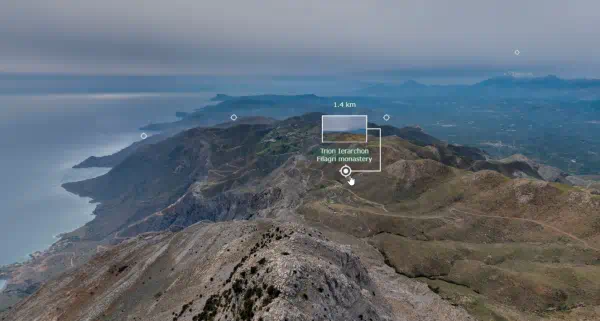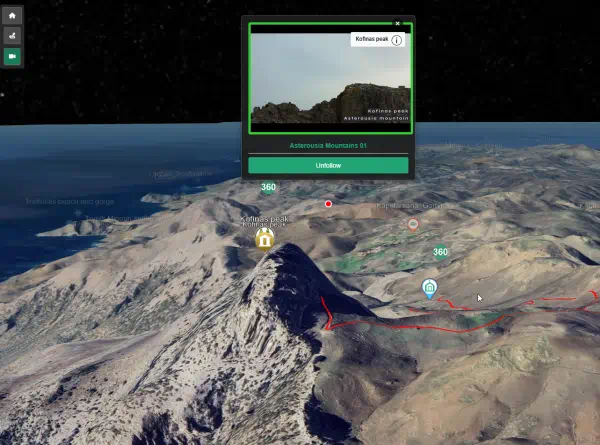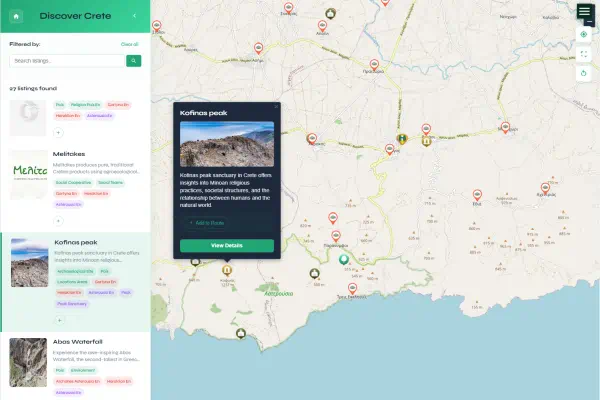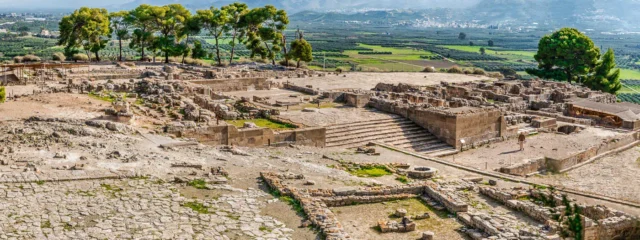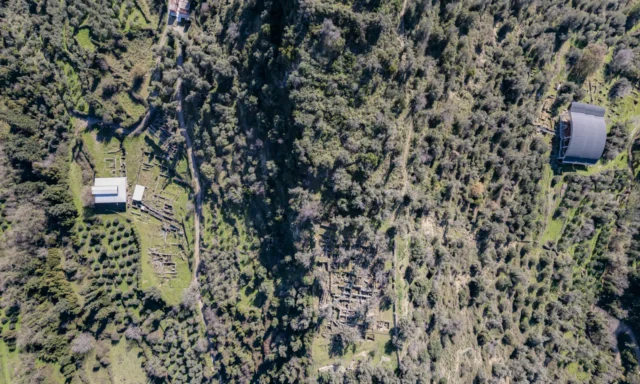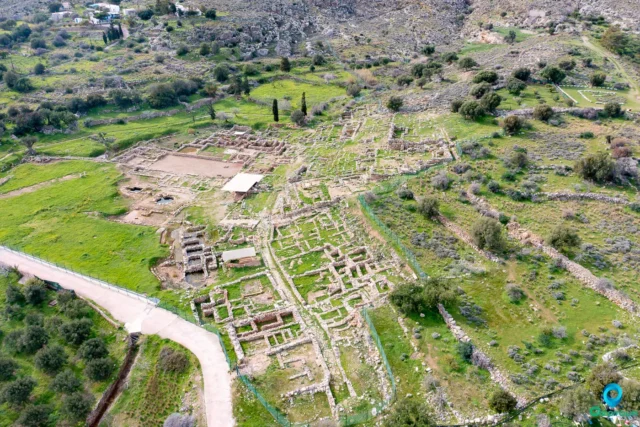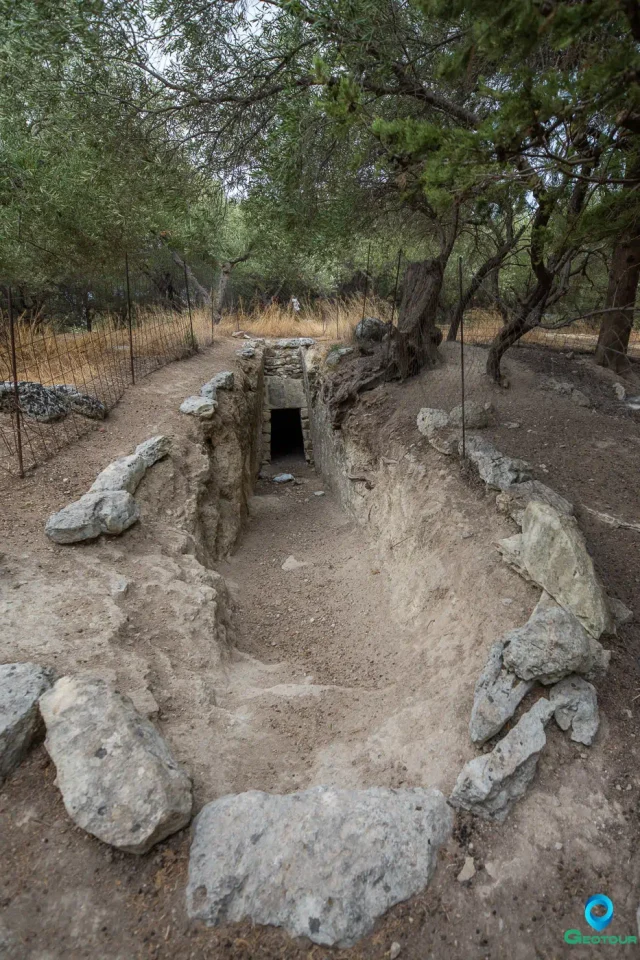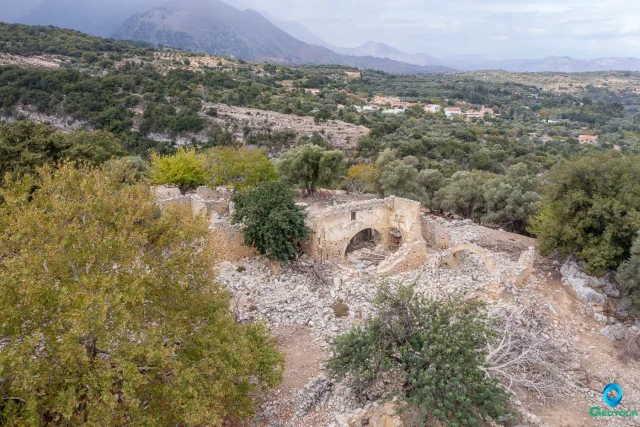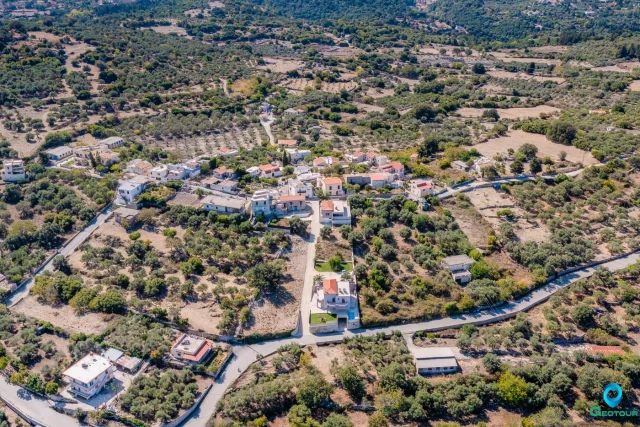Lake Kournas is the only natural body of freshwater on the island of Crete, Greece. It is a significant hydrological and ecological feature located in the eastern part of the Chania regional unit. The lake and its surrounding area constitute a complex ecosystem influenced by the region’s distinct geology, climate, and a long history of human interaction. Its functions range from being a vital habitat for native and migratory wildlife to serving as a crucial water resource and a center for local economic activity.
Location and Geography
Lake Kournas is situated within the administrative boundaries of the Apokoronas municipality, near the border with the Rethymno regional unit. It lies approximately 2.5 kilometers inland from the northern coast of Crete and about 4 kilometers south of the coastal town of Georgioupoli.
The lake is positioned in a basin at the northern foothills of the White Mountains (Lefka Ori) range. The surface of the water sits at an altitude of about 20 meters above sea level. The shape of the lake is roughly pear-like, with a maximum length of 1,087 meters and a maximum width of 880 meters. Its total surface area is approximately 0.58 square kilometers (579 stremmata). The dimensions and surface area fluctuate seasonally in response to rainfall and water abstraction. The maximum recorded depth of the lake is 22.5 meters, with its deepest point being 3.5 meters below sea level.
The lake’s basin is part of a wider catchment area used primarily for grazing and olive cultivation. The surrounding landscape consists of low hills with sparse vegetation dominated by phrygana (low, thorny shrubs) and kermes oak. The northern outflow of the lake has been modified by a dam, which channels water into the Delfinas (or Almyros) River, leading to the Cretan Sea.
Geology and Hydrology
The formation and persistence of Lake Kournas are direct consequences of the area’s geological structure. The lake occupies a doline, a hollow formed through karstic processes. This involves the dissolution of soluble bedrock, in this case limestone, by water over long geological periods, leading to the collapse of the ground and the creation of a basin.
The hydrology of the lake is a dynamic system. The basin’s ability to hold water is due to the presence of impermeable rock formations, such as marl and marl limestones, which form a watertight layer along its eastern and southeastern sides. In contrast, the western and northwestern sides are composed of fractured, permeable limestone from the Tripali geologic unit.
The lake receives water from two primary sources:
- Groundwater Inflow: The main supply comes from two underwater springs, with the most significant one known locally as ‘Mati’ or ‘Amati’. These springs are fed by the vast underground aquifer of the White Mountains, which collects water from rainfall and snowmelt at higher elevations. The inflow from these springs means the lake’s water level can remain relatively stable even during periods of low rainfall.
- Surface Runoff: The lake also collects water from direct rainfall and surface runoff from its surrounding catchment basin. The variation in the lake’s water level typically follows the regional rainfall pattern with a delay of about two months.
Water leaves the lake through two main pathways:
- Outflow to the Sea: A dam, originally built in 1962 and later modified, controls the outflow at the northern end of the lake. When the water level is high, particularly in late winter and spring, water overflows the dam and feeds the Delfinas River, which runs to the sea at Georgioupoli.
- Underground Sinkholes: There are natural sinkholes, known as ‘katavothres’, in the permeable limestone area on the northwestern side of the lake. Water discharges through these sinkholes at a rate proportional to the lake’s water level; the higher the level, the faster the discharge.
The water level of the lake exhibits significant seasonal fluctuation. Historically, this variation was recorded to be between 2 and 4.5 meters, reaching a maximum of 5 meters in years of severe drought. More recent analyses suggest this range has increased to 3.5 to 6 meters. However, data from 2015 to 2023 recorded a total fluctuation of 4.38 meters, closer to the historical estimates. These fluctuations expose a wide sandy shore during the late summer and autumn, which becomes submerged again during the winter recharge period.
History and Etymology
The area around Lake Kournas has been inhabited since antiquity. The lake is mentioned by the 6th-century AD writer Stephen of Byzantium under the ancient name Korisia. It is believed that a temple dedicated to the goddess Korisia Athena was located near its shores. The historical name of the wider province, Apokoronas, is thought to be a corruption of the ancient toponym Ippokorona, which may have been associated with the cult of the goddess.
The name change from Korisia to Kournas is thought to have occurred during the period of Arab rule in Crete (c. 824–961 AD). The word “Kournas” is attributed by some scholars to an Arabic word for “lake” or “bathing place.” Another theory suggests it is a corruption of the Greek word krounos, meaning “spring,” a reference to the underwater springs that feed the lake.
The earliest detailed modern accounts of the lake come from the 15th-century Venetian traveler Cristoforo Buondelmonti, who documented the lake’s abundant eel population during his tour of Crete in 1415. The lake has long been a significant local resource, particularly for its eels, though systematic fishing has not been a major activity in recent history.
Ecosystem and Biodiversity
Lake Kournas is a significant biodiversity hotspot and is protected under the European Union’s Natura 2000 network due to its importance as a habitat for various species. The ecosystem comprises a complex food web involving plankton, invertebrates, fish, reptiles, and birds.
Flora
The lake is surrounded by hydrophilic vegetation, including chaste trees (Vitex agnus-castus) and oleander (Nerium oleander). A significant feature of the lake is its extensive beds of submerged aquatic macrophytes. These underwater plants provide crucial habitat and food for many aquatic organisms. The dominant species include Potamogeton pectinatus and Najas marina, which grow in deeper waters, and species of Chara, which have been observed forming meadows on the lakebed. The presence and health of these macrophyte beds are critical to the lake’s ecological balance, as they contribute to oxygenation and serve as nurseries for fish and invertebrates.
Fish Fauna (Ichthyofauna)
The fish community of Lake Kournas is a mix of native, migratory, and introduced species. The lake’s fish populations have been shaped both by natural colonization and significant human intervention over the last century.
- Native Species:
- Sand Smelt (Atherina boyeri): This species is of marine origin but has established a self-sustaining, landlocked population in the lake. It is a small, pelagic, plankton-eating fish that forms a key part of the food web. Studies have shown that the Kournas population has adapted to the freshwater environment and has a prolonged reproductive season lasting from spring through autumn.
- Freshwater Blenny (Blennius (Salaria) fluviatilis): This is a small, bottom-dwelling fish that is the only member of the typically marine Blenny family to live exclusively in freshwater. It is listed as a protected species in Europe. In Lake Kournas, it inhabits the rocky shallows along the shore, where it reproduces by laying eggs in crevices. Its population is considered vulnerable to significant drops in the lake’s water level, which could expose its nesting sites.
- Migratory Species:
- European Eel (Anguilla anguilla): The eel is a catadromous species, meaning it lives in freshwater and migrates to the sea to spawn. Juvenile eels, known as glass eels, enter Cretan rivers from the sea and make their way upstream to freshwater habitats like Lake Kournas to grow. They remain in the lake for many years, acting as the top fish predator in the ecosystem before maturing and attempting the return journey to the Sargasso Sea to reproduce. Their access to the lake can be hindered by the dam and pollution in the outflowing river.
- Thin-lipped Grey Mullet (Liza ramada): This mullet species can tolerate freshwater and enters the lake from the sea when the outflowing river is flowing strongly during the winter rainy season. They cannot reproduce in the lake and their presence depends on new individuals entering from the sea.
- Introduced (Alien) Species:
- Mosquitofish (Gambusia holbrooki): Originally from North America, this species was intentionally introduced into the lake and other Cretan wetlands in the 1930s as a biological control agent against mosquitoes to combat malaria. It is a highly adaptable, live-bearing fish that has established a very large population. It is a voracious predator of zooplankton and insect larvae and competes directly with native species, particularly the juvenile sand smelt, for food.
- Goldfish (Carassius auratus): This species, native to East Asia, was accidentally introduced into the lake around the late 1990s, likely through the release of aquarium pets. As a bottom-feeding omnivore, it has the potential to severely disrupt the ecosystem by uprooting aquatic plants and increasing water turbidity. Its population currently appears to be controlled by predation from eels and fish-eating birds like cormorants.
- Rainbow Trout (Oncorhynchus mykiss): This North American species was introduced for sport fishing in 1978 and 1984. However, the species failed to establish a self-sustaining population, likely due to unsuitable reproductive conditions, and is now considered to have disappeared from the lake.
Invertebrates
The invertebrate fauna is rich and forms the base of the food web for the lake’s fish and birds.
- Zooplankton: The zooplankton community is dominated by rotifers and copepods. The presence of large-bodied zooplankton, such as large cladocerans (e.g., Daphnia), is notably scarce. This is attributed to intense predation pressure from the lake’s abundant planktivorous fish, primarily the sand smelt and mosquitofish. This top-down control favors smaller zooplankton species that are less vulnerable to fish predation.
- Benthic Invertebrates (Zoobenthos): The lakebed is home to a variety of invertebrates, including snails (gastropods), oligochaete worms, and insect larvae (especially chironomids). Two larger crustaceans are particularly significant:
- Freshwater Shrimp (Palaemonetes antennarius): This small, transparent shrimp is extremely abundant, particularly among the submerged vegetation. It is a detritivore, feeding on decaying organic matter, and serves as a primary food source for eels and water birds.
- Freshwater Crab (Potamon potamios): This crab is native to the Eastern Mediterranean and is common in Cretan freshwaters. It is an omnivore that plays a role in processing organic material on the lake bottom.
Other Wildlife
The lake’s ecosystem supports a notable population of the Balkan Terrapin (Malaclemys terrapin), a rare species of turtle. The lake is also one of the most important sites in Crete for ornithofauna (birdlife). It serves as a vital wintering ground and migratory stopover for numerous water birds, including cormorants, herons, egrets, and various species of ducks.
Human Interaction and Conservation Status
Lake Kournas has become a major center for tourism in the region, attracting a large number of visitors, particularly during the summer. This has led to the development of tavernas, cafes, and recreational activities like paddle boat rentals along its accessible shores. While this economic activity is vital for the local community, it also places significant pressure on the lake’s ecosystem.
The primary threats to the lake’s health are:
- Water Abstraction: The extraction of water for irrigation of nearby farmland and for the drinking water supply of coastal towns poses a significant risk. Over-extraction, especially during dry years, can lead to an unnatural and drastic lowering of the water level. A severe drop could damage the sensitive littoral zone, destroying the nesting sites of the freshwater blenny and the habitats of many invertebrates. This has been identified as a critical threshold, and exceeding the historical minimum water level is considered an “alert event” for the ecosystem.
- Pollution: Runoff from surrounding agricultural areas can carry fertilizers and pesticides into the lake, contributing to nutrient enrichment. Furthermore, wastewater and solid waste from the concentrated tourist activities around the lake pose a direct threat of pollution if not managed properly. While water quality is currently considered acceptable, these pressures increase the risk of eutrophication (an over-enrichment of nutrients that can lead to algal blooms and oxygen depletion).
- Invasive Species: The presence of non-native species like the goldfish and mosquitofish alters the natural food web and increases competitive pressure on native fauna.
Due to its ecological significance, the Lake Kournas area is a designated Natura 2000 site. This status mandates the protection and sustainable management of its habitats and species. Ongoing monitoring of water quality, water levels, and the biological communities is essential to ensure the long-term preservation of Crete’s only natural freshwater lake.
Key Points
- Characteristics (Dimensions)
- Type: Natural freshwater karstic lake.
- Surface Area: Approximately 0.58 km² (579,827 m²), but varies seasonally.
- Maximum Length: 1,080 meters.
- Maximum Width: 880 meters.
- Maximum Depth: 22.5 meters (the lakebed reaches -3.5 meters below sea level).
- Volume: Approximately 7.5 million cubic meters.
- Altitude: 20 meters above sea level.
- Water Level Fluctuation: Varies seasonally, typically by 3.5 to 6 meters.
- History
- Ancient Name: Known as Lake Korisia in antiquity, with a possible temple to Korisia Athena nearby.
- Modern Name: The name “Kournas” likely dates to the Arab period in Crete (9th-10th centuries CE).
- Early Accounts: First described in modern times by Venetian traveler Buondelmonti in 1415, who noted its eel population.
- 20th Century: A dam was constructed in 1962 to control its outflow. Alien species like the mosquitofish (1930s) and rainbow trout (1970s-80s) were intentionally introduced.
- Location
- Region: Crete, Greece.
- Municipality: Apokoronas, Chania regional unit.
- Coordinates: 35°20′06″N 24°16′24″E.
- Setting: Located at the northern foothills of the White Mountains, approximately 2.5 km from the sea.
- Current Status
- Conservation: Protected site under the European Union’s Natura 2000 network and a designated Area for the Protection of Ornithofauna.
- Economy: A major center for local tourism (recreation, hospitality) and a vital source of water for irrigation and drinking.
- Threats: The ecosystem faces significant pressure from water abstraction, potential pollution from agriculture and tourism, and the ecological disruption caused by introduced species like the goldfish and mosquitofish. The water level is closely monitored, as a significant drop below historical minimums is considered a primary risk to the lake’s health.

